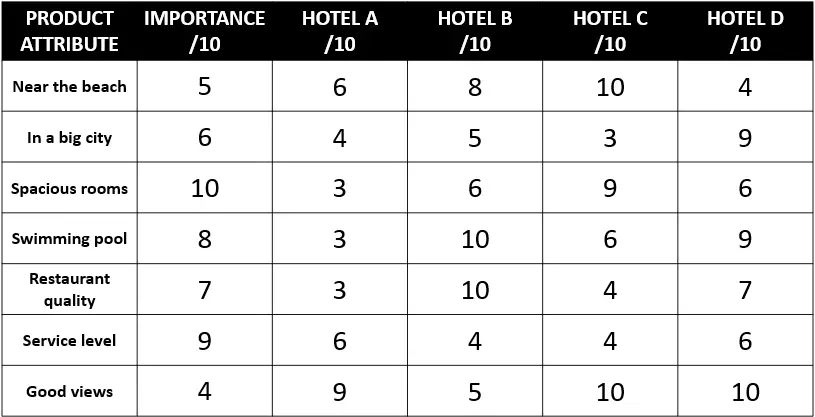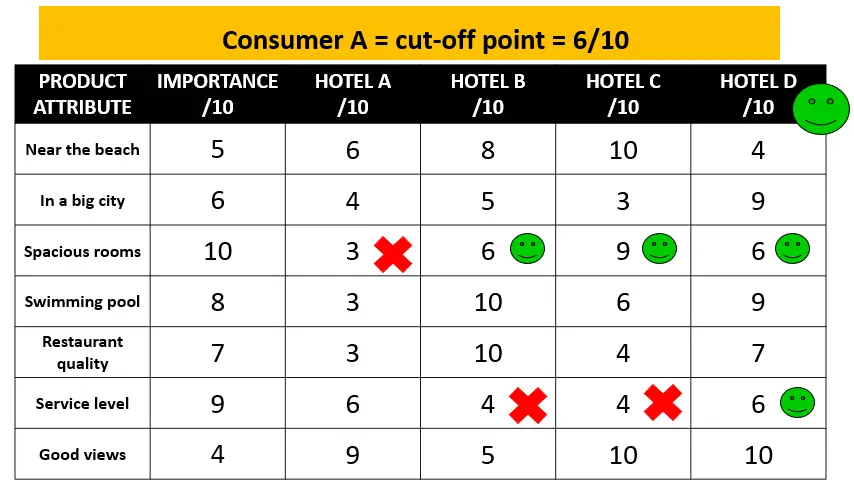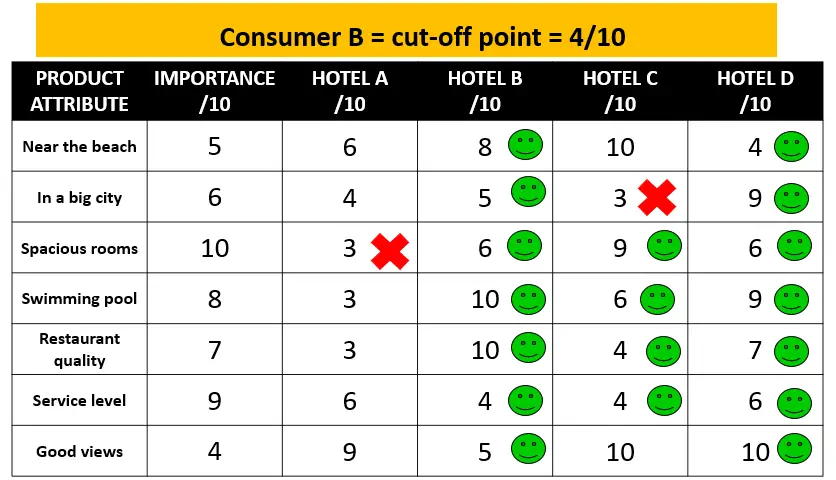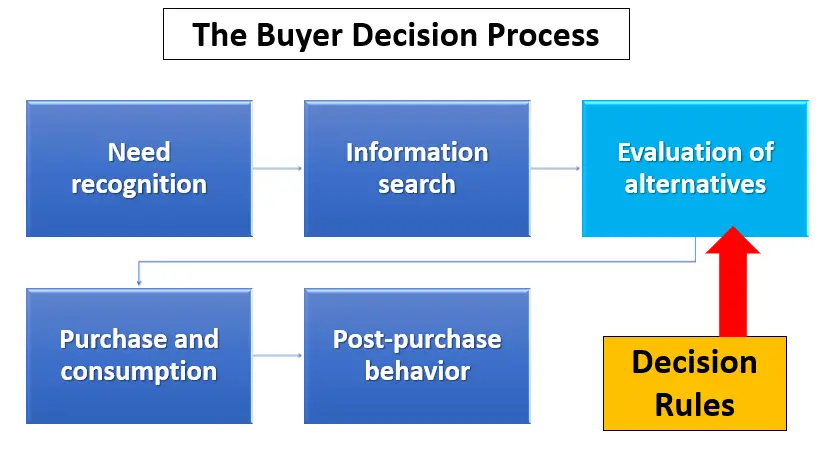What is the Elimination-by-Aspects Decision Rule in Consumer Behavior?
Covered in this article:
- Overview of the Elimination-by-Aspects Decision Rule
- How to Recall the Elimination-by-Aspects Rule
- A Worked Example of the Elimination-by-Aspects Decision Rule
- Why Consumers Would Use the Elimination-by-Aspects Rule
- How Elimination-by-Aspects Rule differs from other Decision Rules
- A Video Summary of the Elimination-by-Aspects Rule
- The Main Types of Decision Rules Used by Consumers
- Where Decision Rules Fit into Consumer Behavior
Overview of the Elimination-by-Aspects Decision Rule
The elimination-by-aspects decision rule is a non-compensatory approach to decision-making for consumers.
This decision rule works much like a knock-out competition. A consumer will work through the product attributes being considered one by one – starting with the most important product attribute to them – and then eliminate any product choices that do NOT meet their minimum requirements.
For example, for a consumer looking to buy a new smart TV their most important attribute might be the size of the screen. Therefore, in the first round of this decision approach they will eliminate any potential product choices that (in their perception) do not meet their minimum requirement for screen size.
After this first round, all remaining products will then be assessed by the consumer’s second most important attribute – and again, perceived underperforming products on that attribute will be eliminated. Products that have been eliminated will not be considered in the second and subsequent rounds of evaluation, regardless of the strength of their other product attributes.
This evaluation process will continue until there is only one suitable product choice.
However, it should be noted that on occasion, they may be two or more relatively equal products that are still remaining at the end of this “knock-out” process. In this case, the consumer will need to implement a second decision rule or raise their minimum expectations per attribute and repeat the elimination-by-aspects rule from the beginning (the most important attribute).
How to Recall the Elimination-by-Aspects Rule
Potentially a way to recall this rule is to rely upon the word “elimination” and recall sports or reality TV game shows where they have “elimination rounds”. This could be like the show Survivor, where contestants are eliminated week by week having been voted out.
Essentially, this decision rule works the same way, where each round a unique attribute is considered and products are ruled in/out (eliminated) based upon that particular attribute.
The word “aspects” refers to components, features, characteristics (etc.) of a product which may be considered as an important product attribute by the consumer in their decision-making.
A Worked Example of the Elimination-by-Aspects Rule
Let’s work through this decision-making approach using an example. For this example, we are going to select between four competing hotels for a holiday.
The following table summarizes the consumer’s assessment of these hotels. As you can see, in the left-hand column is a list of product attributes.
And in the second column there is an importance rating for each attribute, with the higher score indicating that the attribute is more important.
When using the elimination-by-aspects rule the consumer will start with the most important one and then progressively work down to the least important one in the table, until there is one remaining product choice, or all product attributes have been considered.
And as we move across the table, we can see that each attribute for each hotel has been scored out of 10 – with higher scores representing greater quality or performance as perceived by the consumer.
Let’s now see how two different consumers would implement this rule and what hotel they would select as a result.
Consumer A will work through the attributes in importance and their cut-off point is 6/10. This means that brands scoring 5 or less will be eliminated.
And Consumer B’s cut-off point is only 4/10, where only brands scoring 3 or less will be eliminated.
As we can see, although both consumers are using the same decision rule, they have structured it according to their needs and preferences. This way two consumers using the same approach to decision-making are likely to have different purchase outcomes.
Consumer A
As we can see in the following table – where the smiley face means that the attribute meets their requirements of 6/10 and the cross means that it fails to meet that required quality/performance.
In this case, this consumer would select Hotel D as their preferred choice. In the first round of elimination, they considered “spacious rooms” because it was their most important attribute. As we can see, Hotel A was eliminated in this round and would be removed from further consideration.
In the second round, moving to the second most important attribute of “service levels”, we can see that Hotels B and C were eliminated at this stage. Leaving Hotel D as the only remaining choice.
Consumer B
We have a similar table for the second consumer below. Remember that they are using the same decision rule approach, but they have opted for a lower score/expectation for each product attribute. This is likely to reduce the number of products eliminated each round.
At the end of this process, we have two suitable remaining, these being Hotel B and Hotel D, as each of these hotels met the consumers minimum requirement for every attribute considered.
In this case, Consumer B will now need to implement a second decision rule (or modify their approach to the rule by raising the minimum score/expectation per attribute) to make a final purchase decision.
Why Consumers Would Use the Elimination-by-Aspects Rule
This rule is relatively analytical and structured and is probably the non-compensatory decision approach which is closest in operation to the compensatory model and has a similar approach to the lexicographic rule.
So why would a consumer use this approach? There are several reasons including:
- It is an analytical approach that works through the product attributes in order of importance to ensure that the resulting choice is a good fit to their needs
- This approach would suit an analytical mindset/personality
- Provided the minimum score/expectation per attribute is set at a reasonable level, the end result should be a well-balanced product that provides overall value
- Potentially, some consumers may find this approach “fun”, as it is somewhat a game of knockout – like with sports.
- It is helpful for high-involvement purchase decisions where an overall set of product attributes need to be considered, rather than a reliance on 1-2 attributes only
- The consumer is experienced and confident with assessing the product category using a broad choice of attributes
How does the Elimination-by-Aspects Rule differ from other Decision Rules
As mentioned above, the elimination-by-aspects rule is somewhat similar to the lexicographic rule.
As a reminder, the lexicographic rule seeks to find the product that is the best-performing on the most important attribute to the consumer. However, if two or more products are considered similar on that attribute, then the consumer would repeat the process for the second most important attribute.
The key difference is that with the lexicographic rule, the consumer is generally seeking high expectations per product attribute, whereas with the elimination-by-aspects rule the consumer is more likely to set moderate expectations and end up with a more balanced choice.
This is unlike the lexicographic rule where the consumer will more than likely choose a product that is very strong on a single attribute only.
It has some similarities with the compensatory decision-making approach, in that often a selection of attributes is considered. However, the key difference is that products may be ruled out completely if an important product attribute is perceived as weak or underperforming.
This differs from using a compensatory model, which will allocate scores to all attributes and look at the total score outcome, rather than being reliant upon the perceived performance of any single product attribute.
And this rule is also quite different from the disjunctive decision rule where a product that is strong on a single attribute only will be considered. Generally, with this rule, a product with a combination of strong attributes will usually be the winner.
A Video Summary of the Elimination-by-Aspects Rule
The following video provides a summary of this decision rule.
The Main Types of Decision Rules Used by Consumers
The main decision rules that are covered in most consumer behavior textbooks are listed as:
- Compensatory decision-making and
- Non-compensatory decision rules, which include:
- conjunctive,
- disjunctive,
- elimination-by-aspects,
- lexicographic, and
- affect referral
The following video provides a brief overview of each of these decision rules.
Where Decision Rules Fit into Consumer Behavior
Decision rules are used by consumers in the evaluation of alternatives stage of the buyer decision process – as shown in the following diagram. At this point in the process, they have gathered information and now must make a selection from competing alternatives.
Related Articles




